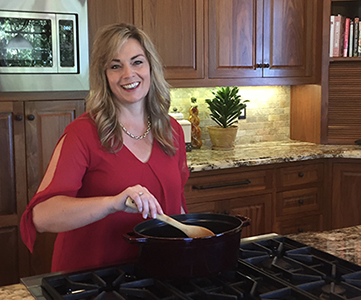6 Tips to Reduce Hot Flashes and Lower Blood Sugar Levels
Ask any woman who is either going through menopause or is postmenopausal what the most annoying symptom of “the change” is and you are likely to hear hot flashes. Hot flashes can strike at the least convenient times: while at work, while out having a glass of wine with friends or during the middle of a peaceful night sleep. Suddenly, you feel the flash build as your temperature begins to climb, your face turns flush, your heart races and perspiration begins to wash over you like you just stepped out of a sauna.
Hot flashes and night sweats are uncomfortable and can disrupt a woman’s sleep patterns, interfere with work and leave us feeling tired and frustrated.
But hot flashes might also be a sign of another problem that few people talk about – high blood sugar levels and insulin resistance.
So, what causes hot flashes?
If you ask this question, most people including your doctor may not give you a clear-cut answer. Many of them will respond with either “I don’t know” or “It’s not clear what causes hot flashes”. One common answer is that hot flashes are caused by declining estrogen levels and some women report that using bioidentical estrogen and progesterone therapies has helped to reduce the number and the intensity of hot flashes.
But there is still one very important factor that triggers hot flashes that not many people talk about…
Blood sugar dysregulation or insulin resistance
Insulin is a hormone produced by the pancreas that is released when we eat, to store glucose or blood sugar.
When eating or drinking beverages that are highly processed and high in sugar, the pancreas is required to secrete more insulin than normal into the blood stream to remove the excess glucose. In time, the body can become resistant to storing the glucose, creating a condition known as insulin resistance which potentially can lead to type 2 diabetes.
People with insulin resistance experience stubborn weight gain especially around vital organs; fatigue, mood swings, difficulty concentrating and yes …. HOT FLASHES!
But the good news is insulin resistance can be reversed with a few simple changes to lower blood sugar levels and, if caught early, no medications are needed.
How to Reduce Hot Flashes and Lower Blood Sugar Levels
Hot flashes are a fact of life for approximately 70% of menopausal women. If you are experiencing them just know that you are not alone. But the good news is we do have control to some degree with these simple steps:
- Cut the Sugar – Reduce or eliminate all added sugars especially in the evening before bed including sweet treats, sweetened beverages and even fruit juice. Instead of drinking fruit juice eat the whole fruit. You will consume less sugar in the form of fructose and the fiber of the fruit will slow the uptake of sugar into the blood stream.
- Avoid Alcohol – Alcohol effects blood sugar and is a primary trigger for hot flashes. Wine and cocktails with sweetened mixers tend to be the worst offenders. Which is sad for those of us who enjoy a nice glass of chardonnay in the evening.
- Rest – Make sure to get plenty of rest. Go to bed at a reasonable time and shoot for 7 to 8 hours of sleep each night. Even if your sleep is disturbed, a regular sleep schedule will help to rejuvenate you.
- Reduce Stress – This is probably one of the most challenging ones for the clients I coach. With our jobs, family life and feeling tired due to hormonal changes, stress is a reality. But stress and perceived stress are also triggers for hot flashes and hormonal imbalances. Reduce stress as much as possible by including a 5- or 10-minute meditation in your day, going for a leisurely walk at lunch or after work, or treating yourself daily to something that you enjoy and that rejuvenates you.
- Get Active – Exercise, even just a brisk walk for 15 to 30 minutes, reduces high levels of insulin and blood glucose levels. It helps relieve stress and releases happy endorphins to make you feel better and have more energy.
- Eat a real food diet that includes protein in the form of fish, poultry and meat; plenty of high fiber vegetables in a variety of colors; and healthy fats like coconut oil, olive oil, and avocado oil along with small amounts of fruit, nuts and seeds.
Follow these 6 steps and get your hot flashes and blood sugar under control.
Need support? Contact Lacee for help with any of your health coaching questions.
Note: The onset of menopause is a great time to get a wellness check by your doctor or naturopath. Ask them to check your hormone levels, blood sugar levels and maybe even a nutrient panel to see if there are any vitamins or minerals you might need to include in your diet to optimize your health and “Live Life Healthy and Happy.”




You actually make it seem so easy with your presentation but I find this topic to be actually something that I think I would never understand. It seems too complicated and very broad for me. I am looking forward for your next post, I will try to get the hang of it!
To the simply28.com owner, Thanks for the detailed post!
Nice blog right here! Also your website lots up very fast! What web host are you the usage of? Can I get your affiliate hyperlink on your host? I wish my web site loaded up as quickly as yours lol
Simply a smiling visitant here to share the love (:, btw great design and style. “Justice is always violent to the party offending, for every man is innocent in his own eyes.” by Daniel Defoe.
After study a few of the blog posts on your website now, and I truly like your way of blogging. I bookmarked it to my bookmark website list and will be checking back soon. Pls check out my web site as well and let me know what you think.
Hey! Would you mind if I share your blog with my twitter group? There’s a lot of people that I think would really enjoy your content. Please let me know. Thank you
The subsequent time I learn a weblog, I hope that it doesnt disappoint me as a lot as this one. I mean, I know it was my option to read, but I really thought youd have one thing fascinating to say. All I hear is a bunch of whining about something that you might fix in case you werent too busy on the lookout for attention.
This is a topic close to my heart cheers, where are your contact details though?
Wonderful blog! I found it while browsing on Yahoo News. Do you have any tips on how to get listed in Yahoo News? I’ve been trying for a while but I never seem to get there! Appreciate it
I have read some good stuff here. Definitely worth bookmarking for revisiting. I wonder how much effort you put to create such a excellent informative web site.
Great wordpress blog here.. It’s hard to find quality writing like yours these days. I really appreciate people like you! take care
hello!,I really like your writing very a lot! percentage we keep in touch more approximately your article on AOL? I need an expert on this area to resolve my problem. May be that’s you! Looking ahead to look you.
Dear simply28.com owner, Thanks for the great post!
I appreciate, cause I found just what I was looking for. You have ended my four day long hunt! God Bless you man. Have a nice day. Bye
We stumbled over here from a different web address and thought I should check things out. I like what I see so i am just following you. Look forward to looking over your web page again.
Can I just say what a relief to find someone who actually knows what theyre talking about on the internet. You definitely know how to bring an issue to light and make it important. More people need to read this and understand this side of the story. I cant believe youre not more popular because you definitely have the gift.
I believe this web site has got some real wonderful info for everyone. “The human spirit needs to accomplish, to achieve, to triumph to be happy.” by Ben Stein.
I got good info from your blog
I’d should check with you here. Which isn’t something I usually do! I enjoy reading a publish that can make people think. Additionally, thanks for permitting me to comment!
This website is my aspiration, really wonderful design and perfect articles.
Heya i’m for the first time here. I came across this board and I find It really useful & it helped me out a lot. I hope to give something back and aid others like you helped me.
F*ckin¦ tremendous things here. I am very satisfied to look your post. Thanks so much and i am having a look forward to touch you. Will you kindly drop me a e-mail?
Does your site have a contact page? I’m having problems locating it but, I’d like to send you an e-mail. I’ve got some ideas for your blog you might be interested in hearing. Either way, great website and I look forward to seeing it improve over time.
Hi would you mind letting me know which webhost you’re working with? I’ve loaded your blog in 3 different internet browsers and I must say this blog loads a lot quicker then most. Can you recommend a good hosting provider at a fair price? Cheers, I appreciate it!
When I originally commented I clicked the -Notify me when new comments are added- checkbox and now each time a comment is added I get four emails with the same comment. Is there any way you can remove me from that service? Thanks!
I would like to express some thanks to the writer just for bailing me out of this type of issue. After exploring through the internet and finding strategies which are not beneficial, I thought my life was gone. Being alive minus the solutions to the problems you have fixed by way of your main posting is a crucial case, as well as those that would have badly damaged my entire career if I had not come across your site. Your main mastery and kindness in controlling every item was precious. I am not sure what I would’ve done if I hadn’t come upon such a stuff like this. I’m able to now look forward to my future. Thanks so much for your expert and results-oriented guide. I will not be reluctant to suggest the sites to anyone who would need assistance on this subject.
Heya i’m for the first time here. I found this board and I in finding It truly helpful & it helped me out much. I’m hoping to offer one thing again and help others such as you helped me.
“The Accident Attorneys In My Area Awards: The Most Sexiest, Worst, And Strangest Things We’ve Ever Seen plano accident attorney, Natalie,
fantastic post, very informative. I’m wondering why the other specialists of this sector do not realize this. You should continue your writing. I’m confident, you have a huge readers’ base already!